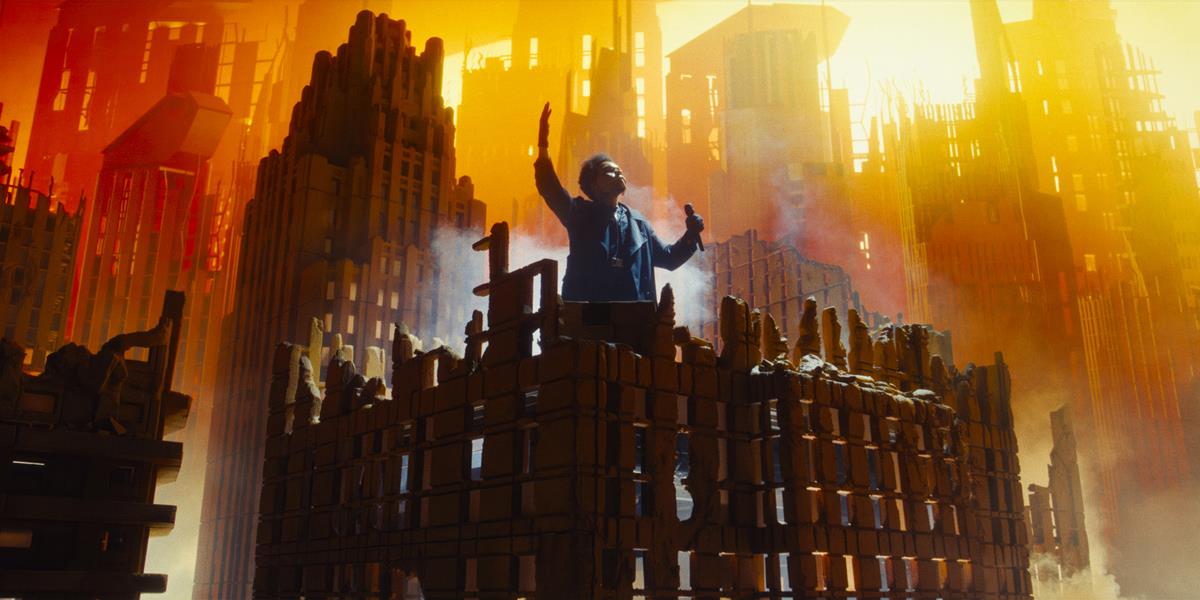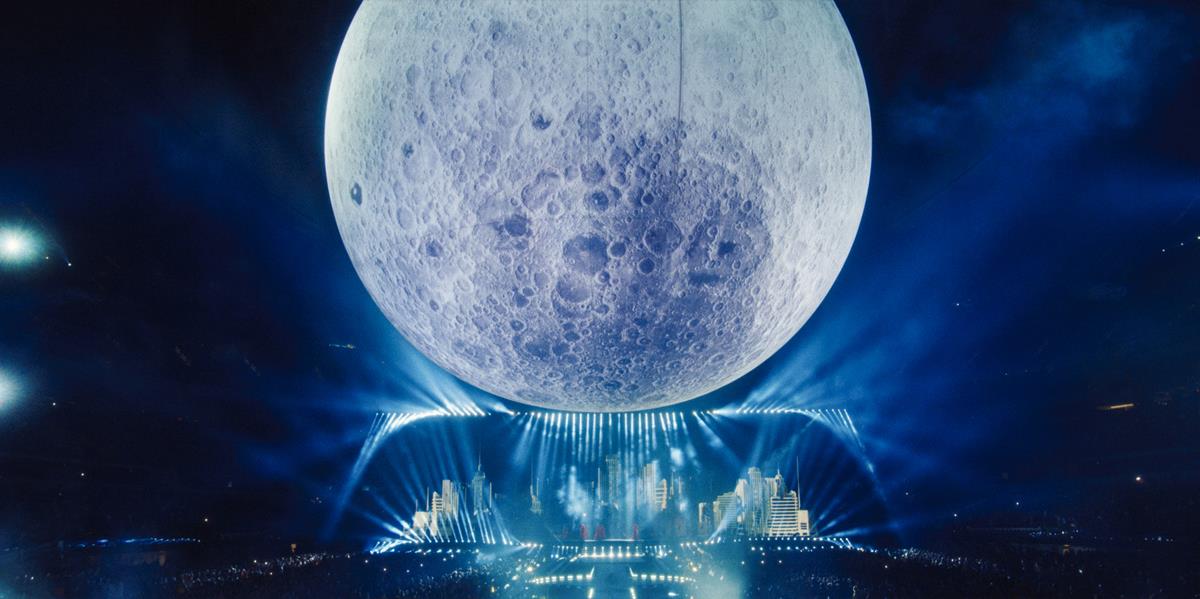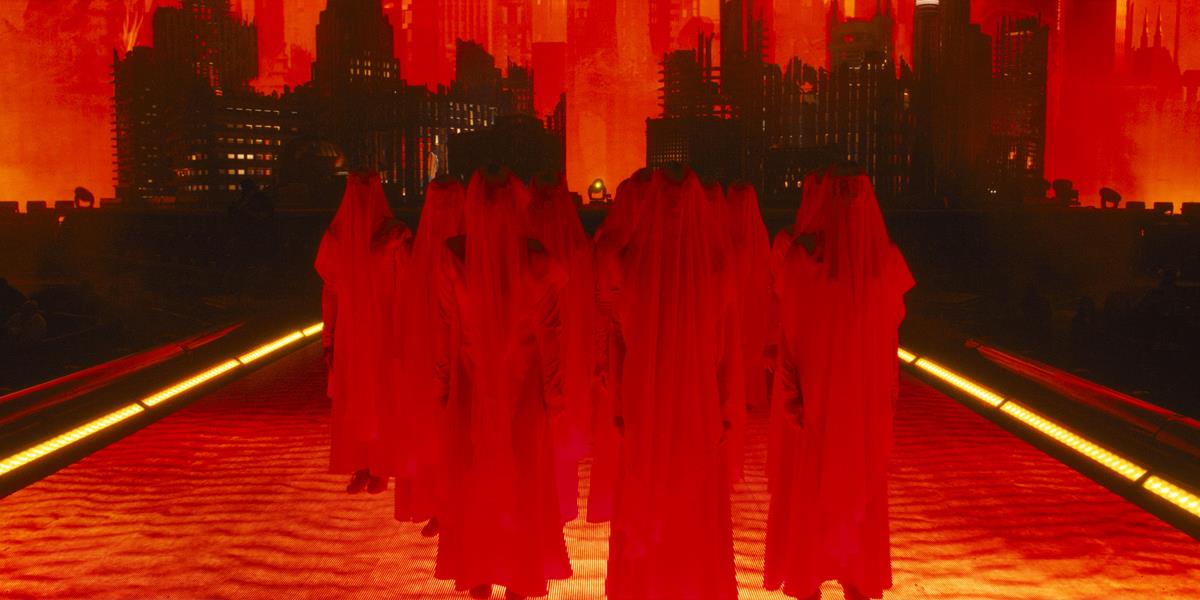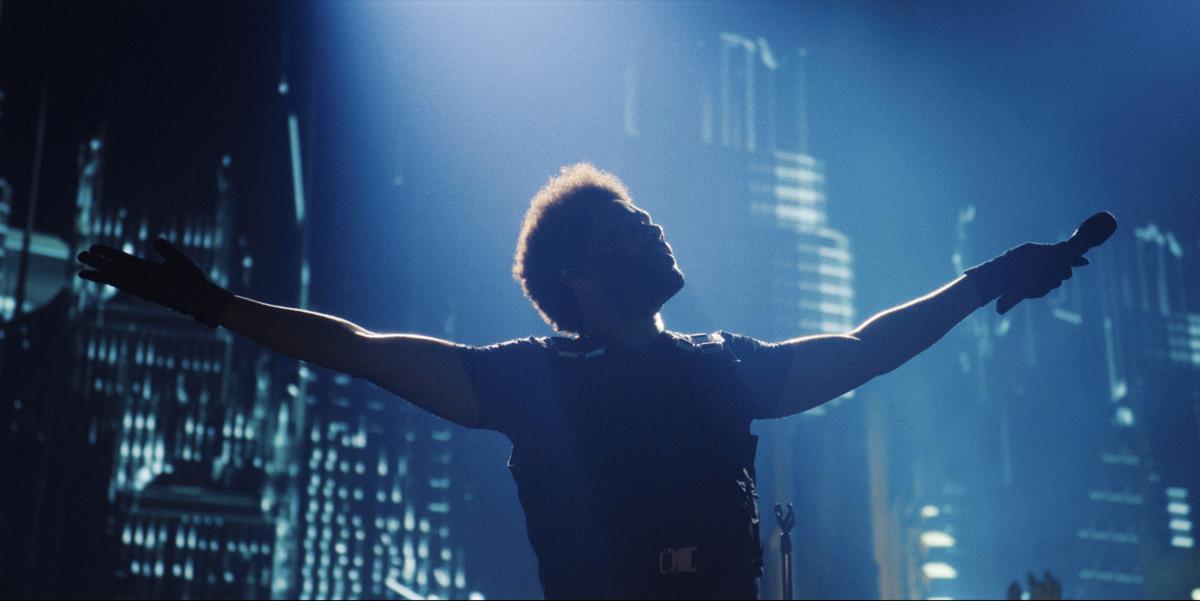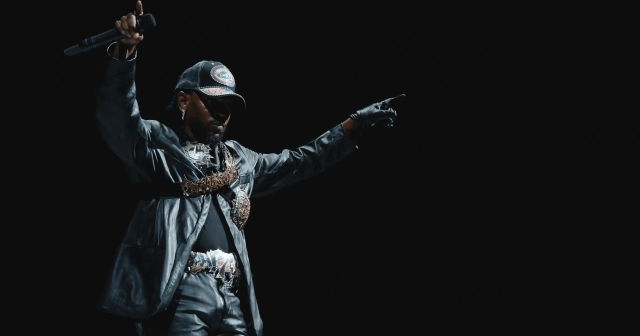TL;DR
- Both nights of The Weeknd’s spectacular 90-minute show at Inglewood’s SoFi Stadium in LA were recorded for an HBO concert special, “The Weeknd: Live at SoFi Stadium,” which is now streaming on HBO Max.
- Director Micah Bickham employed roughly 25 Sony Venice cameras outfitted with Angenieux and Canon Cine zoom lenses to capture footage of the live concerts.
- The production team partnered with a company called Live Grain to add texture and grain to the concert footage to emulate 35mm film stock.
Last November The Weeknd, aka Abel Makkonen Tesfaye, put on a spectacular 90-minute plus show at Inglewood’s SoFi Stadium in LA. Both nights were recorded for an HBO concert special, The Weeknd: Live at SoFi Stadium, which is now streaming on HBO Max.
It was the last stop of the first leg of the “After Hours til Dawn” tour, and Tesfaye pulled out all the stops to reinforce his performance artist handle but still confound and confuse the critics as to what music genre to place him in.
Direction was by Micah Bickham, whose collaboration with the artist goes back to the Starboy album in 2015. He talked to NAB Amplify about how the show was created, recorded and broadcast.
“My focus with The Weeknd is particularly around live production,” Bickham said. “We have quite the partnership really from the Starboy era around 2015. It’s been a handful of years just to understand the world they’re creating from an album point of view and how that translates in to live.”
SoFi stadium was primarily chosen for the recording as The Weeknd was doing two nights there. Both nights would be recorded and then cut together. “Just thinking how I wanted to shoot it and present it, we had to shoot across the two nights, plus a handful of pickups that we ended up doing. Also being LA, it was just perfect.”
The discussion before the show about how they wanted the concert film to look took quite a few diversions but a cinematic theme was always front and center. “We talked a lot about cinematic integrity. Yes it’s a concert and yes it’s an artist performing these songs but with a world being created and shaped inside of it,” he said.
“We talked about what the DNA and visual language of this film was but in the end for me it had a lot to do with how we presented it more like a film and less like a concert. What I mean by that is when you watch the film the pace and the tension that the pace creates is pretty unusual for a typical concert film.
“We wanted you to sit with the artist and digest what was happening right in front of you not through an edit and cut that might pull you away too quickly. We wanted you to live in it, when you see it there’s something that resonates differently than a typical concert film.”
The Weeknd’s live shows have already made headlines, especially his 2021 Super Bowl halftime show, which he had reportedly underwritten to the tune of several million dollars. But the show was to be nominated for an Emmy for Outstanding Variety Special (Live), Outstanding Lighting Design/Lighting Direction for a Variety Special, and Outstanding Technical Direction, Camerawork, Video Control for a Special.
The SoFi concerts were specifically staged to allow viewers see the most of The Weeknd. Tesfaye had the run of the center of the stadium with an apocalyptic Toronto skyline at one end and a huge suspended moon at the other. No sign of the band, who were hidden out of sight. Tesfaye was on his own apart from 33 dancers parading as red-shrouded sirens who walked as one.
Concert films can be free-running, sometimes allowing the camera positions to operate without timecodes, picking and choosing shots as they go. Bickham wanted a tighter regime for SoFi. “For this particular project there were a couple of differences, just because of the scale of it. It was important to me early on that if I just monitored the board and did a pure just shoot for capture and I didn’t create a line cut, my feeling was that we weren’t going to able to hold that many cameras accountable to each moment,” he said.
“So the way I directed it was a little bit of a hybrid in the sense that I did cut a line cut. When a director cuts a line cut there’s an immediacy that takes place from the operators that you’re working with. Everybody sits up a little straighter and there’s a little more tension than if I asked them to ‘just shoot and I’ll nudge you around.’
“Certainly there are times when that’s important and the best way to approach it. For this I felt creating a little bit of tension and immediacy was important so everyone stayed focused. It’s a long show, top to bottom it’s just under two hours. It’s an easy scenario even for the best team to kind of settle in and perhaps not necessarily to be on top of every single moment throughout the show. So yes, we cut it but with a series of pick ups too.”
These were mostly single close-up Steadicam shots featuring The Weeknd and the dancers. Adding them to the two nights at the stadium gave Bickham a substantial editing job, but inevitably it was all about finding the show. “We wanted to break it apart and understand the shape of the narrative and how we could build it in the edit.”
With around 25 Sony Venice cameras in play — both first- and second-generation, but mostly second — there was a lot of footage to work with. Lenses were primarily Angenieux and Canon Cine zooms, with a couple of prime lenses employed on handheld cameras. “They were all human-operated and were all on my Multiview and so we’re cutting the full volume of the 25 throughout the night,” Bickham detailed. “From night one to night two we augmented the positions of some of those 25 cameras just to enlarge out coverage. That gave us a slightly different mindset going in to night two. It would just accentuate what we had already done on the previous night.”
Designing the cut, it was always planned to let it breathe, especially around Tesfaye who was mostly alone in such a huge space. Bickham explains the thinking: “It was partly because it gives the audience an opportunity to be on stage with him. That’s a very unusual experience especially for a stadium film. Additionally by doing that it creates a tension. The audience are expecting you to cut, they’re expecting to be moved on to something wide or something different and when you don’t do that and you stay kind of locked in to that position something really interesting happens; it makes the next shot that much more impactful.
“So in other words, we kind of lingered even if the song ramped up and became more manic. We didn’t let the pace of the moment dictate the pace of the film.”
Bickham and Le Mar Taylor, The Weeknd’s creative director, had talked a lot about letting moments develop in front of the lens and not blasting through the coverage. “We wanted our performance to be more like a film edit.”
The concert film was meant to be celebratory career moment for Tesfaye and the means of capture was always up for discussion, with even IMAX put forward as a medium. “We did think about using 35mm film, in fact through our discussion we did end up partnering with a company called Live Grain,” Bickham recounted. “We wanted the concert film to have representation of the texture of film to push in to a space where you don’t particular see it. So that was a huge part of our decision making even through the grade and the finishing. It’s got a timelessness with this textural element to it and just feels different from a typical concert picture.”
The use of the Live Grain process is usually for digitally shot movies. NAB Amplify previously reported on Stephen Soderbergh’s No Sudden Move using the process, but for a live production it’s new.
READ MORE: “No Sudden Move:” The Lush Look of Steven Soderbergh’s Neo-Noir (NAB Amplify)
“The cameras didn’t have any filtration in place just to make sure the process wasn’t disrupted. Live Grain is essentially real time texture mapping. A lot of great films that were shot digitally used Live Grain to make it feel like it’s 35mm. In a multi-camera almost two hour production 35mm itself isn’t really practical with the mag changes and the amount of film you use.”
The use of Live Grain was in fact introduced by HBO, which has an ongoing relationship with the company. “It’s been tested by them many times on films but our film was maybe the first time being used for a live concert application or certainly one of the first.”
The post effect of film grain really nails the timeless cinematic effect, but was there ever an option to broadcast the concert live? “There was a time when we considered a one day IMAX special but when HBO got involved we realized we had a great partner for what eventually we wanted to do and it tied in with the upcoming The Idol drama series.
“Ultimately we were able to bring a more caring approach to it, we could take our time.”
Next, Watch This:
EXPANDING THE HORIZONS OF LIVE PRODUCTION:
Looking to stay ahead of the curve in the fast-changing world of live production? Learn how top companies are pushing the boundaries of what’s possible in live events and discover the cutting-edge tools and technologies for everything from live streaming and remote workflows to augmented reality and 5G broadcasting with these fresh insights from NAB Amplify:
- Public Cloud Is Ready for Live Production at Scale
- How 5G Will Impact Live Production Workflows
- Planning a Move? Considerations for Live Production in the Cloud
- “Kendrick Lamar Live in Paris” Brings Cinematic Production to a Streamed Event
- Why Live Production Has to Up Its Sustainability Game


